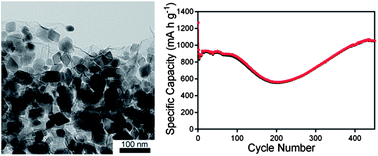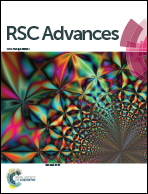Highly crystallized Fe2O3 nanocrystals on graphene: a lithium ion battery anode material with enhanced cycling
Abstract
A facile one-step hydrothermal method has been developed to synthesise Fe2O3-graphene nanocomposites using L-arginine as the hydrolysis-controlling agent. In the synthesised composites, highly crystallized Fe2O3 nanocrystals with an average size of ∼50 nm are firmly anchored on the graphene sheets. When applied as the anode material for lithium ion batteries, the resulting Fe2O3-graphene nanocomposites show excellent cycling stability and good rate performance. The composites deliver a capacity of 946 and 634 mA h g−1 at a current density of 200 and 2000 mA g−1, respectively. After cycling at 200 mA g−1 for 450 cycles, a capacity of 1049 mA h g−1 can still be maintained.


 Please wait while we load your content...
Please wait while we load your content...